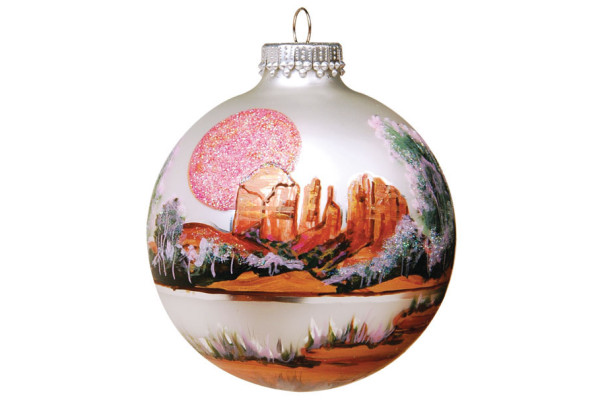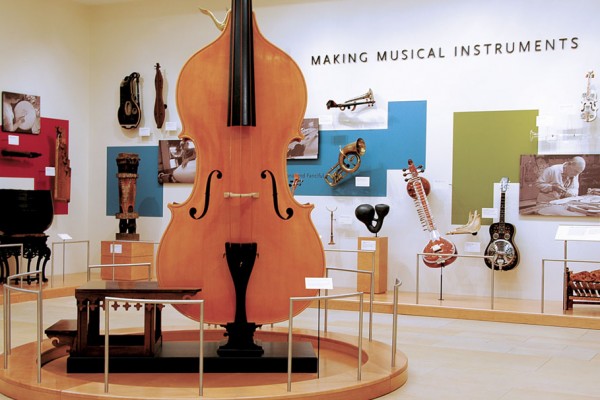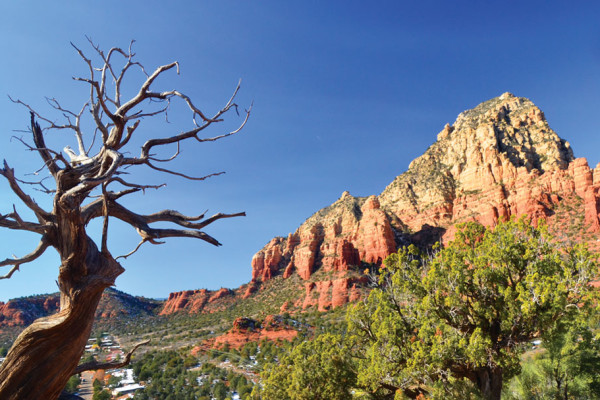Continued (page 4 of 5)
Strawberry and Pine
Distance from the ‘Y in Sedona (one way): 75 miles Attractions: Mogollon Rim, ice cream parlor, goat farm, oldest standing school in Arizona
How can anyone resist a summer daytrip to sister towns with the names Strawberry and Pine? Both locations are every bit as charming as their names would suggest. Throw in a highway with lazy curves that hug the Mogollon Rim, and you’re set for the ultimate Sunday drive.
Your road trip begins at the ‘Y in Sedona. Head south on State Route 179 and south on Interstate 17 to Highway 260. Drive east on 260 through the town of Camp Verde. The highway quickly changes from four lanes to two and makes a gradual climb, leading you through a pastoral landscape of grassy fields and stubby trees. After you’ve been driving for 50 miles, you’ll enter the pines of the Tonto National Forest. When you reach the junction of highways 260 and 87, continue east on 260 (and south on 87). Sixty-five miles into your trip, you’ll enter the quaint town of Strawberry, which, according to the United States Census Bureau, has a total area of 10.2 square miles. For now, pass through Strawberry and continue another three miles to Pine. Pine’s main drag is about one-mile long and easy to walk. Park on the side of Highway 260 and wander among the funky shops and restaurants. Stop at The Honey Stand for fruits, nuts, jams, butter and locally made honey. Have lunch at the Nifty 50’s Diner, but don’t miss the Gingerbread House, a combination old-fashioned ice cream parlor and antique shop. Head back toward Strawberry, but this time turn right on Fossil Creek Road. One-and-a-half miles down the road, you’ll find the Strawberry Schoolhouse, built in 1884. Owned by the Arizona Historical Society, the schoolhouse, complete with an iron bell on its gable, is the oldest standing school in Arizona. You can peek in the windows for a glimpse of old desks and a blackboard, but if you really plan ahead, call 928-476-3547 and make an appointment for a tour. Continue down Fossil Creek Road and follow the signs to the Ranch at Fossil Creek and Fossil Creek Creamery. If you’re a sucker for locally made foodstuffs, Fossil Creek Creamery is your pot of gold at the end of the rainbow. Owners John and Joyce Bittner built the working ranch in 1996 and added the creamery in 2004. When you drive up, you’ll be greeted by bleating goats and statuesque llamas. Inside the small shop, John and Joyce make and sell goat cheese, goat fudge, goat’s-milk yogurt and goat’s-milk soap (all under a sign that reads, “We owe our success to udders”). Some of Sedona’s most popular restaurants serve cheese from the creamery. Call in advance and make reservations to tour the ranch and learn how goat’s milk is turned into cheese and fudge. The ranch is open to the public, Saturdays and Sundays from 9 a.m. to 5 p.m. and during the week by appointment. Call 928-476-5178 or visit www.ranchatfossilcreek.com.
Sunset Crater Volcano and Wupatki National Monuments
Distance from the ‘Y in Sedona (one way): 83 miles Attractions: lava fields, volcanic craters, ruins, views of the Painted Desert and the San Francisco Peaks, wildlife
The 36-mile loop road that encompasses both Sunset Crater Volcano and Wupatki national monuments north of Flagstaff was one of our favorite drives before we even lived in Arizona. It’s especially enchanting during this time of year when monsoon storms build over the nearby San Francisco Peaks and the light of the setting sun bathes the crater and pueblo ruins in a warm orange glow. Bring a picnic with you and take advantage of numerous picnic spots along your route.
From the ‘Y, head north on State Route 89A through Oak Creek Canyon, then drive north on Interstate 17 and east on Interstate 40. Exit U.S. 89 north (exit No. 201). After you’ve been traveling 44 miles, you’ll make a right into Sunset Crater Volcano National Monument. The entrance fee is $5 per person (good for seven days) and is valid for both national monuments. After driving on the road for about two miles, you’ll come upon a visitors center, which explains the geological history of Sunset Crater. (A series of powerful eruptions between 1040 and 1100 created the crater.)



